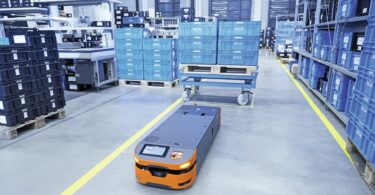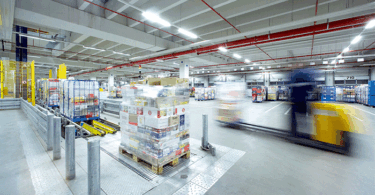By equipping autonomous and semi-autonomous vehicles with intelligent sensor technology, companies are developing safe, efficient distribution (DC) and fulfillment center (FC) operations that meet and exceed customer service requirements.
The modern supply chain is evolving at a pace that most organizations can’t keep up with. As evidenced by the interruptions and roadblocks that surfaced during the global pandemic, the need to infuse intelligent, insightful technology into the world’s supply chains has become greater than ever. No longer willing to leave these things to chance, companies are investing in advanced platforms that help them work smarter, better, and faster in any business conditions.
Driven by a massive uptick in e-commerce exacerbated by the pandemic, everchanging customer demands, and ongoing labor challenges, companies are pairing autonomous and semi-autonomous vehicles with advanced sensor technology to solve these pain points while also improving their efficiency, productivity, and profitability.
The Need for Speed
Current business conditions are driving more companies to automate their fulfillment and distribution operations. “If 20 employees working at a large DC or FC contract COVID-19, that operation will probably close down for a period of time to deal with the problem,” says Bryan Duncan, national sales manager, retail distribution at SICK USA. “The more automation that operation has in place, however, the better the chances that it can manage that risk and cover those work shifts.”
Companies also need flexible, scalable solutions that help them respond more effectively to the market changes, all while helping organizations do more with less. When sensor-enabled autonomous vehicles are leased on a service-based model, for example, companies can use as many (or as few) as they require, and then reposition those assets as needed.
“There’s been a lot of thought on freeing hours up to handle many new tasks and challenges associated with the global pandemic,” says Brain Corp.’s John Black. “We’ve seen a 25% to 50% utilization increase on machines during the pandemic. It allows customers to get a higher level of cleaning with the autonomous equipment and then use operators for disinfecting tasks and other important logistical tasks. Our automation is allowing them to free up those hours.”

When equipped with sensors, mobile platforms become more intelligent and intuitive than their non-sensor-based counterparts. They not only navigate a fulfillment center or distribution center floor in a very safe and efficient manner, but they also incorporate encoders, Auto ID, and other advanced technologies that support the modern warehousing environment in a very cost-effective manner.
For example, when mounted on an automated guided vehicle (AGV), mobile 3D vision uses its three-dimensional sensing field to detect the entire area in front of the vehicle. This prevents the vehicle from colliding with objects that are hanging down or protruding, or with the fork arms of other vehicles. Or, when integrated with shuttle systems, mini safety laser scanners allow the implementing of advanced safety functions while conforming to standards and to avoid collisions between the shuttles themselves.
These are just some of many examples of how sensors can enable the modern, efficient, productive warehouse or DC. By handling repetitive motion/operational type work, the machines allow companies to allocate human labor to more important projects. They also help companies establish socially-distanced workplaces and make up for labor shortages and high employee turnover.
Quick Scale-Ups, Service-Based Models
Because they can scale up quickly and without the need for onboarding or training, sensor-enabled autonomous and semi-autonomous vehicle fleets can easily be scaled up ahead of peak seasons, Black Friday, and other periods of high demand. Using the robotics-as-a-service (RaaS) model, companies can acquire that equipment to manage the peaks, and then return it when demand normalizes.
By adding sensors to robotics and other mobile platforms, companies get vehicles that respond faster, maneuver more easily, and maintain very safe travel paths. They also offer companies reliable material flow consistency, and the ability to circumvent an existing labor shortage that was exacerbated by the global pandemic. The platforms also help existing employees by removing some of the physical burden of these jobs, shortening their travel times within the DC, and managing other previously-manual tasks.
![]()
In this Making the Case, we explore the convergence of intelligent sensors with mobile platforms to create smart, responsive warehouse automation and show how these solutions produce significant ROI for logistics operations. Here's what's covered in this report:
- Infusing Intelligent, Insight Tech into Global Supply Chains
- Sensors: The Eyes and Ears of the Modern Warehouse
- Making the Case for Safe, Flexible Mobile Platforms Enabled by Intelligent Sensors
- Accommodating Market Volumes and Staying Competitive
- Harnessing the Power of Industry 4.0
Download the full Making the Case report today to learn all about how intelligent sensors enable safe, flexible mobile platforms.





